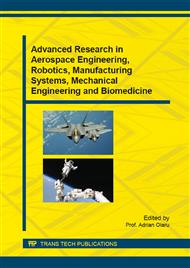p.24
p.29
p.35
p.45
p.50
p.57
p.63
p.75
p.80
Transitory Dynamics Evaluation inside Driving System of Demolition-Cutting Technological Equipment due to Variable Tool-Material Interactions
Abstract:
Computational dynamics of technological equipments dealing with intensive, shock-like and various working regimes frames the area of this research paper. A widely used type of demolition-cutting equipment supplied by hydrostatical driving system was adopted, and ordinary scenarios of equipment exploitation have been proposed in order to dignify the very short but strong transitory states deeply depending on the material characteristics and the regime parameters. Elastic, dissipative and plastic components have been considered to compose the global characteristic of the processed material interacting with cutting tool. The authors propose a simplified rheological model intended for modeling and simulation of demolished structural elements based on composite materials, like reinforced concrete. This model is very useful for simulation the variable dynamics of the interaction between the demolition-cutting equipments and the composite elements in order to evaluate the parameters evolution within the process, and obviously, to optimize driving system for minimize transitory effects and vibratory evolutions. The advantage of this computational approach results from the reduced resources involved by simulation tasks, taking into account the global evaluation of the resistant forces usually required for this kind of behavioral analysis.
Info:
Periodical:
Pages:
50-56
Citation:
Online since:
November 2015
Authors:
Price:
Сopyright:
© 2015 Trans Tech Publications Ltd. All Rights Reserved
Share:
Citation:


